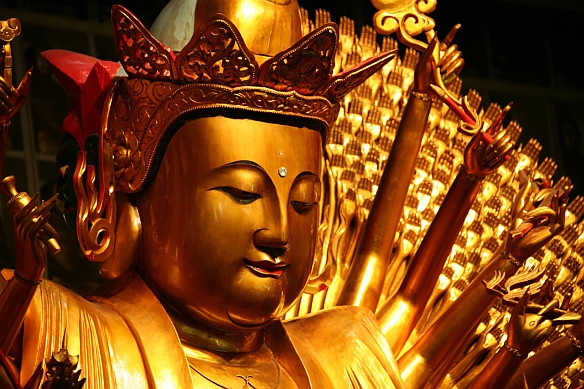 [Admin’s note: This spring, volunteers and staff participated in a 7-day Guan Yin Practice Retreat. During the Guan Yin session, participants recite the name of Guan Yin Bodhisattva. In our Chan tradition, meditation brings the mind back to whatever method of practice we are doing, whether it’s mental awareness, reciting, bowing, etc… Inevitably, the mind wanders off, and we gently bring it back. Once familiar with the motion of wandering off, we see what compels the mind to stray and develop a resistance against the habituation of that e/motion.]
[Admin’s note: This spring, volunteers and staff participated in a 7-day Guan Yin Practice Retreat. During the Guan Yin session, participants recite the name of Guan Yin Bodhisattva. In our Chan tradition, meditation brings the mind back to whatever method of practice we are doing, whether it’s mental awareness, reciting, bowing, etc… Inevitably, the mind wanders off, and we gently bring it back. Once familiar with the motion of wandering off, we see what compels the mind to stray and develop a resistance against the habituation of that e/motion.]
If you encounter something troublesome, just recite “Namo Guanshiyin Bodhisattva” and the trouble will go away. Troubles fear Guanshiyin Bodhisattva, because he can contemplate them and find their cause; as soon as he discovers their cause, the troubles go away. This is a most wonderful method, the best way to solve problems.– Venerable Master Hsuan Hua
I have a tendency to be a bit of a skeptic; among the many minds I can adopt, one of them is definitely the mind of a scientist. So there’s always been something about statements like the one above that is difficult for me to accept. The voice has a bit of magical realism to it. Is this something that I’m actually expected to put faith in, much less put into practice? I consider this perspective of mine to be cultural, to a large extent. After all, why would any critically-educated American mind, brought up in a world grounded in scientific progress in the face of superstitious and corrupt religious institutions, ever consider swallowing a statement like this whole?
Whether by synchronicity or chance, I brought my scientist’s mind with me to my first Guan Yin Session at the City of Ten Thousand Buddhas (CTTB) in the summer of 2009. Along with a bit of what I consider to be healthy skepticism, I also brought with me a great deal of curiosity about the mind and its various capacities, as well as a great deal of enthusiasm for exploring and experimenting with the limits of what my mind is capable of. (For another look at the culture of skepticism, see Doug Powers’ post from a few weeks back on conviction in experience.) Having just completed my fourth Guan Yin session, one of the things that I’ve learned is that this is actually a great attitude to bring, and something that I still value highly.
One could ask, “Does Guan Yin really exist, or not?” I think a better question might be, “Does compassion exist?”
Master Hui Neng once said, “Guanshiyin is kindness and compassion.” One could ask, “Does Guan Yin really exist, or not?” I think a better question might be, “Does compassion exist?” Compassion, like Guanshiyin Bodhisattva, is empty and interdependent. In other words, if you have compassion, it exists. If you don’t have compassion, it doesn’t exist. Likewise, the substance of Guanshiyin Bodhisattva is one’s own heart and mind. If this is the case, then what is meant by faith in the Buddhas and Bodhisattvas? For myself, Guan Yin recitation is definitely a devotional practice; I have faith that Guan Yin’s virtue and vows are worthy of praise, and that such praise is itself meritorious. Just as important to me is my faith in her method of cultivation, a faith gained through critical examination of practice and results. This is a faith in inquiry, not in doctrine. I could say that it’s a faith in a question rather than an answer; or that it is a faith in a practice, one that doesn’t rely on having rote answers to questions of inherent existence, but rather relies on a balance of confidence and skepticism in investigation.
The Venerable Master often emphasized the importance of putting your principles into practice. The Buddha himself said, “As the wise test gold by burning, cutting, and rubbing it, so are you to accept my words after examining them and not merely out of regard for me.” I suppose that as a seeker of wisdom, when a person of such wise repute as the Venerable Master suggests that a particular method is most wonderful, I am inspired to put it to the test.
